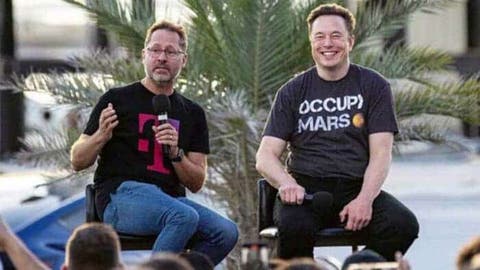Recently, T-Mobile and SpaceX announced a plan to provide smartphone networking services. According to the announcement, this service will be available almost anywhere in the United States. It will be available through a new “satellite-to-cellular” service. Elon Musk also announced some related information on Twitter today. He said that the upcoming second-generation Starlink Internet satellite includes a mobile phone antenna, which can be connected to the mobile phone of T-Mobile in the United States, and may also connect to other operators.
The new technology will leverage SpaceX’s second-generation Starlink satellites in low-Earth orbit and T-Mobile’s nationwide mid-band 5G spectrum to provide “near-complete coverage” across much of the United States, in addition to territorial waters. If successful, the technology will eliminate “mobile network dead spots,” allowing users to stay connected beyond cell towers.
T-Mobile and SpaceX hope to go global in the future
T-Mobile and SpaceX said they hope to establish reciprocal roaming agreements with international carriers to offer the service globally in the future.
“This is important, it means your phone has no dead spots anywhere in the world,” SpaceX CEO Elon Musk said in a news conference announcing the plan. “We’re very excited to partner with T-Mobile to do this together.”
T-Mobile said the “vast majority of smartphones” already connected to its network will be compatible with the new “satellite-to-cellular” service. Also, the satellite connection will use the smartphone’s existing cellular chip. Thus, there will be no need for a Starlink terminal or any other hardware. According to T-Mobile, the “vast majority” of existing smartphones will be compatible with its satellite-connected service, so the feature shouldn’t have to be used on Apple’s upcoming iPhone 14 models, which were previously said to have a satellite-enabled connection function. Bloomberg’s Mark Gurman has reported that the iPhone 14 models may have satellite connectivity for emergency use. However, he also claims that Apple’s partner may be satellite company Globalstar, not SpaceX.
SpaceX plans to build a Starlink satellite constellation in low Earth orbit
According to new reports, SpaceX plans to build a second-generation Starlink satellite constellation in low Earth orbit. This new satellite constellation will come with top-notch antennas. Furthermore, it will also allow smartphones to connect through T-Mobile’s mid-band 5G spectrum without any additional hardware. T-Mobile claims that the service would provide “almost complete coverage anywhere a customer can see the sky,”. However, Elon Musk claims it would also work when a person has their phone in their pocket or in their car.
What is the purpose of a satellite connection?nbsp;T-Mobile and SpaceX say the satellite-to-phone service is primarily designed for areas without existing cellular coverage to eliminate mobile dead spots. The service isn’t meant to replace faster cell phone networks in cities and suburbs. However, it is to ensure that people in areas without cell towers can stay connected for basic communication via text messages and eventually phone calls.
Where will it be available?
When and where will the service be launched?nbsp;T-Mobile and SpaceX plan to launch the beta service in late 2023, starting in select regions of the United States. The service will eventually cover most of the continental U.S., Hawaii, parts of Alaska, Puerto Rico and U.S. territorial waters. T-Mobile and SpaceX said they hope to establish reciprocal roaming agreements with international carriers to offer the service globally in the future.
What’s the cost of this service?
How much will this service cost? T-Mobile CEO Mike Sievert said the company plans to offer Starlink satellite connectivity on its “most popular package” at no extra cost. For some of the lower-priced plans, T-Mobile may charge a monthly fee to use the service, which will be priced “well below” what existing satellite service providers do, Sievert said. However, there is no specific information on the exact cost of this service in the United States.
What will this service support?
Does the service work with phone calls and text messages? What about iMessage? According to T-Mobile and SpaceX, Starlink’s direct satellite connection to smartphones will initially work with SMS and MMS text messages and “participating messaging apps”. However, the announcement didn’t mention any participating messaging apps, so it’s unclear whether Apple’s iMessage service will be supported.
As for the network, Musk claims that the initial network speed is only 2~4Mbps. This can only work effectively for text messages and phone calls.
Separately, Musk responded to a question on Twitter about whether the connections would work with Tesla’s electric vehicles. Some cars are currently connected to AT&T’s LTE network. According to Musk, the answer is yes.
SpaceX’s second generation of Starlink to launch next year
Tesla and SpaceX CEO Elon Musk said via Twitter that the second generation of Starlink will be launched next year. This generation will provide connections for mobile phones across the world. The implication of this service is that it will eliminate mobile network blind spots globally. However, as of now, there is no information on the specifics of this second-generation Starlink.
SpaceX also plans to build a “Starlink” network consisting of about 12,000 satellites in space to provide Internet services between 2019 and 2024. Last week, SpaceX launched another 53 Starlink satellites. The total number of Starlink satellites has now reached 3,108, of which about 2,845 are still orbiting the earth.
In January of this year, SpaceX shelved plans to launch 30,000 Starlink satellites using a Falcon 9 rocket and instead focused on using SpaceX Starships to launch second-generation Starlink satellites. This means that SpaceX may “begin launching the second-generation system of Starlink in March 2022”.
